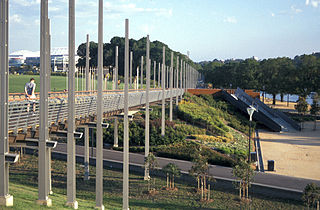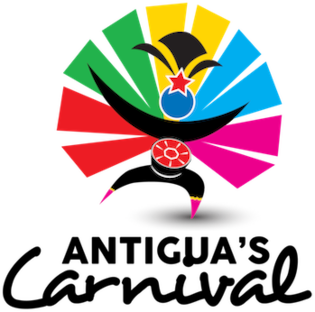
The Albert Park Circuit is a motorsport street circuit around Albert Park Lake in the suburb of Albert Park in Melbourne. It is used annually as a circuit for the Formula One Australian Grand Prix, the supporting Supercars Championship Melbourne SuperSprint and other associated support races. The circuit has an FIA Grade 1 license.

The Yarra River or historically, the Yarra Yarra River, is a perennial river in south-central Victoria, Australia.

The Portland Rose Festival is an annual civic festival held during the month of June in Portland, Oregon. It is organized by the volunteer non-profit Portland Rose Festival Foundation with the purpose of promoting the Portland region. It includes three separate parades, along with a number of other activities.

Elizabeth Street is one of the main streets in the Melbourne central business district, Victoria, Australia, part of the Hoddle Grid laid out in 1837. It is presumed to have been named in honour of governor Richard Bourke's wife.

Melbourne tram route 109 is operated by Yarra Trams on the Melbourne tram network from Box Hill to Port Melbourne. The 19.3 kilometre route is operated out of Kew depot with A and C class trams. It was popularised in the hit song 'The Summer of the 109' by star-studded Facebook comedy influencer Rompa Stompaz.

Birrarung Marr is an inner-city park between the central business district in Melbourne, Victoria, Australia and the Yarra River. It was opened in 2002. The name refers to the bank of Birrarung, the 'river of mists', in the Woiwurrung language of the Wurundjeri people, the Indigenous inhabitants at the time of European colonisation of the Melbourne area.

The Alexandra Gardens are located on the south bank of the Yarra River, opposite Federation Square and the Melbourne Central Business District, in Victoria, Australia. The Gardens are bounded by the Yarra River to the north, Princes and Swan street bridges, with Queen Victoria Gardens and Kings Domain across Alexandra Avenue to the south. The gardens are part of the Domain parklands which stretch to the Royal Botanic Gardens and were first laid out in 1901, under the direction of Carlo Catani, Chief Engineer of the Public Works Department. The Alexandra Gardens were named in honor of Alexandra of Denmark, in the year her reign as Queen Consort of the United Kingdom and the British Dominions and Empress consort of India began. The Alexandra Gardens are listed on the Victorian Heritage Register due to their historical and archaeological significance.

Yarra Park is part of the Melbourne Sports and Entertainment Precinct, the premier sporting precinct of Victoria, Australia. Located in Yarra Park is the Melbourne Cricket Ground (MCG) and numerous sporting fields and ovals, including the associated sporting complexes of Melbourne and Olympic Parks. The park and sporting facilities are located in the inner-suburb of East Melbourne. In the late 1850s, many of the earliest games of Australian rules football were played at Yarra Park, which was known at the time as the Richmond Paddock.
The Bendigo Easter Festival, also known as the Bendigo Easter Fair, is an annual event held in Bendigo, Victoria, Australia, since 1871 with the exception of 2020 and 2021 due to the COVID-19 pandemic. The festival includes the Easter procession which sees Dai Gum Loong, the world's longest imperial dragon, dance through the streets.

Jack Perry and Douglas McKenzie — were an entertainer duo from Melbourne who were known and billed professionally as the clown act, Zig and Zag. They appeared on Australian television from its inception in 1956 to 1999 beginning with Peters Fun Fair (1956–69). They featured on the annual Moomba parade, and were regulars at annual charity events including the Good Friday Appeal for the Royal Children's Hospital. Perry was also an actor on television serials and presenter whilst McKenzie, was also a radio and television presenter and producer and former soldier. In March 1999 the duo permanently parted company after it was revealed that Jack Perry had been convicted in 1994 of indecent assault on his granddaughter.

The Carnival in Rio de Janeiro is a festival held every year before Lent; it is considered the biggest carnival in the world, with two million people per day on the streets. The first Carnival festival in Rio occurred in 1723.

Woiwurrung and Taungurung are Aboriginal languages of the Kulin nation of Central Victoria. Woiwurrung was spoken by the Woiwurrung and related peoples in the Yarra River basin, and Taungurung by the Taungurung people north of the Great Dividing Range in the Goulburn River Valley around Mansfield, Benalla and Heathcote. They are often portrayed as distinct languages, but they were mutually intelligible. Ngurai-illamwurrung (Ngurraiillam) may have been a clan name, a dialect, or a closely related language.

Princes Bridge, originally Prince's Bridge, is a bridge in central Melbourne, Australia that spans the Yarra River. It is built on the site of one of the oldest river crossings in the city, and forms a gateway into the central city from the south. The bridge connects Swanston Street on the north bank of the Yarra River to St Kilda Road on the south bank, and carries road, tram and pedestrian traffic. The present bridge was built in 1888 and is listed on the Victorian Heritage Register.

Birdman Rally is a competition where members of the public build home-made gliders, hang gliders and human-powered aircraft, ranging from very serious aircraft to mere costumes, leap from a river– or sea–side jetty, or from a bridge, and compete for distance and entertainment value.

The Antiguan Carnival is a celebration of the emancipation of slavery in the country held annually from the end of July to the first Tuesday in August. The most important day is that of the j'ouvert, in which brass and steel bands perform for much of the island's population. Barbuda's Carnival, held in June, is known as Caribana. The Antiguan and Barbudan Carnivals replaced the Old Time Christmas Festival in 1957, with hopes of inspiring tourism in Antigua and Barbuda. Some elements of the Christmas Festival remain in the modern Carnival celebrations.

The culture of Melbourne, the capital of the Australian state of Victoria, encompasses the city's artistic, culinary, literary, musical, political and social elements. Since its founding as a British settlement in 1835, Melbourne has been culturally influenced by European culture, particularly that of the British Isles. During the 1850s Victorian gold rush and in the decades the immediately followed, immigrants from many other parts of the world, notably China and the Americas, helped shape Melbourne's culture. Over time, Melbourne has become the birthplace of a number of unique cultural traits and institutions, and today it is one of the world's most multicultural cities.

The Hudson–Fulton Celebration from September 25 to October 9, 1909 in New York and New Jersey was an elaborate commemoration of the 300th anniversary of Henry Hudson’s discovery of the Hudson River and the 100th anniversary of Robert Fulton's first successful commercial application of the paddle steamer. The maritime achievements of Hudson and Fulton foreshadowed the importance of the river to New York's progress and identity. Organizers used the event not only to display the success of the two men, but also the status of New York City as a world city and the achievements of its citizens.
William Townsend Onus Jnr was an Aboriginal Australian political activist, designer, and showman, also known for his boomerang-throwing skills. He was father of artist Lin Onus.
Virginia Fraser was born on 28 December 1947 in Melbourne, Victoria. She was an Australian First Nations artist, writer, curator and advocate for women artists. Her art practice consisted mainly of video and installation works, often made in collaboration with Destiny Deacon. Fraser died on 26 January 2021, aged 74.






















